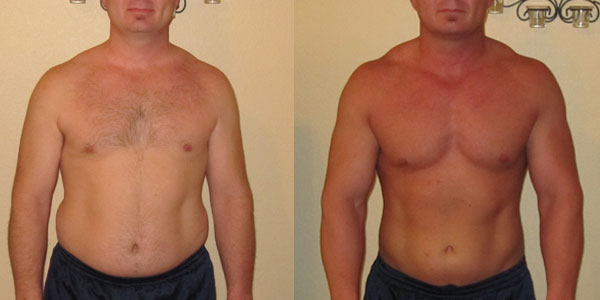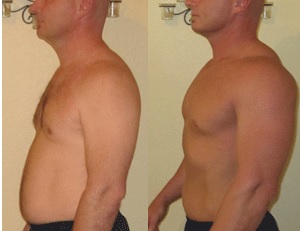I have worked out (on and off) for 27 years. I say on and off because sometimes in my life I have let myself go. I am 5’9. I have weighed between 165 lbs and 220 lbs. I have had a 29 inch waist and a 40 inch waist. I am currently built and very muscular, but I have been a fat ass.
Looks do matter. And more than looks, your physical stature matters. Muscular men automatically are given more respect than skinny men. Fat men get the least amount of respect.

Look at the above picture. That is me after realizing I had let myself go, and then busting my ass for 15 weeks.
Now I am 42 years old, I have a 31 inch waist and weigh 205 lbs. I bench 385 lbs, leg press 1150 lbs and do pull-ups with 90 lbs strapped onto my waist. I am complimented on my body all the time. In business I am automatically looked at like a leader. When I am out, at least a dozen people ask me how to eat or work out. People get out of my way when I walk into a club. Chicks drool when I am at the lake. Am I trying to be arrogant? No, but I am trying to motivate your ass.

 Not all women love muscular men. Mostly the out of shape women who know damn well they can’t get that muscular man say they don’t like him. But hot, petite, tight bodied young women LOVE muscular men. Like I said, I am 42. The oldest girl I have been with for years was 23, 117 lbs at 5’7. My current girl friend is simply gorgeous at 5’2, 96 lbs, D cup, with long soft hair and big doe eyes. Every day she touches my body and tells me how hot I am.
Not all women love muscular men. Mostly the out of shape women who know damn well they can’t get that muscular man say they don’t like him. But hot, petite, tight bodied young women LOVE muscular men. Like I said, I am 42. The oldest girl I have been with for years was 23, 117 lbs at 5’7. My current girl friend is simply gorgeous at 5’2, 96 lbs, D cup, with long soft hair and big doe eyes. Every day she touches my body and tells me how hot I am.
And trust me, until I developed my attitude and body, I had never heard that from a girl. I am bald, wickedly scarred on the back of my head, with a large nose. My attitude and body have made me hot…. so be it.
So my advice is get in a gym. Typically you can get into a gym for $30 bucks a month. So no excuses about money.
Thanks to our “Sue Happy” society, here is my medical disclaimer.
Medical Disclaimer
As with all diet and fitness programs, consulting a Doctor or medical professional before starting is always a good idea. This information is for educational and informative purposes only and is not intended to replace medical or professional advice.
Though diet and nutrition plans used to control metabolic disorders and disease can work, it is a very complicated science, and the information contained here is my personal study and observations, and is not to be used for the purpose of controlling any metabolic disorders or diseases. The purpose of this diet and fitness information is to help average healthy people reach cosmetic fat loss and/or muscle building goals by educating you in proper nutrition, sleep and exercise guidelines.
No health or medical claims are made for my program. I do not warrant, lead, guide or in any way want you to believe or expect that the nutritional and fitness information presented here will: cure, heal, or correct any illness, metabolic disorder, or medical condition.
I am not a medical doctor, registered dietitians, certified clinical nutritionist or professional coaches. I am a student of body mechanics and fitness principles, and I have spent many years seeking to learn to unleash my body and grow. These are my principals and are not endorsed by any legal or medical entity.
If you have diabetes, chronic hypertension, high blood cholesterol, cardiovascular disease, or any other medical condition or metabolic disorder requiring special nutritional considerations, I suggest you consult a health care professional with a clinical nutrition background (MD, RD, or CCN) for your special nutrition program.
A nutritional plan is not enough to be effective by itself. You must combine a great diet, a targeted exercise program, and rest to achieve the desired results. If you have been sedentary and are unaccustomed to vigorous exercise, you should obtain your physician’s clearance before beginning an exercise program.
The American College of Sports Medicine (ACSM) recommends that apparently healthy individuals who are male and over 40 to have both a physical exam and a diagnostic exercise test prior to starting a vigorous exercise program. A diagnostic exercise test and physical examination is also recommended in individuals of any age who exhibit two or more of the major coronary risk factors (smoking, family history of heart disease, elevated blood cholesterol, elevated blood pressure, and diabetes). Any individual with a known history of heart disease or other heart problems should be required to have a medical evaluation including a graded exercise test before engaging in strenuous physical activity.
By using these diet and fitness guidelines, you agree that you have read the above medical disclosure, you agree, and you will hold harmless the author (me), and I shall have neither liability nor responsibility to any person or entity with respect to any of the information contained in this program. You (the user) assumes all risk for any injury, loss or damage caused or alleged to be caused, directly or indirectly by using any information described in this course.
And I look damn good naked.
KEY DEFINITIONS
Metabolism Definition:
The whole range of biochemical processes that occur within us (or any living organism). Metabolism consists both of anabolism and catabolism (the buildup and breakdown of substances, respectively). The term is commonly used to refer specifically to the breakdown of food and its transformation into energy.
 Anabolism Definitions:
Anabolism Definitions:
Anabolic is the constructive metabolism; the synthesis in living organisms of more complex substances from simpler ones. Think muscle growth.
Catabolism Definition:
Catabolic is the metabolic breakdown of complex molecules into simpler ones, often resulting in a release of energy. Think muscle loss.
Protein Definition:
A large molecule composed of one or more chains of amino acids in a specific order determined by the base sequence of nucleotides in the DNA coding for the protein. Proteins are also referred to as Amino Acids (AA’s) or Branched Chain Amino Acids.
Proteins are required for the structure, function, and regulation of the body’s cells, tissues, and organs. Each protein has unique functions. Proteins are essential components of muscles, skin, bones and the body as a whole.
Examples of proteins include whole classes of important molecules, among them enzymes, hormones, and antibodies.
Protein is one of the three types of nutrients used as energy sources by the body, the other two being carbohydrate and fat.
Calories per Gram of Protein: 4 calories
Carbohydrate Definition:
Mainly sugars and starches, together constituting one of the three principal types of nutrients used as energy sources (calories) by the body. Carbohydrates can also be defined chemically as neutral compounds of carbon, hydrogen and oxygen. All carbohydrates (except for dietary fiber) are converted by the body into sugar (glucose) to be used as fuel for the body or stored as fat.
Carbohydrates come in simple forms such as sugars and in complex forms such as starches and fiber. The body breaks down most sugars and starches into glucose, a simple sugar that the body can use to feed its cells. Complex carbohydrates are derived from plants. Dietary intake of complex carbohydrates can lower blood cholesterol when they are substituted for saturated fat.
Calories per Gram of Carbohydrate: 4 calories
Fiber Definition:
The parts of plants that cannot be digested, namely complex carbohydrates. Also known as bulk or roughage.
Complex carbohydrates from plants are rich in starch and fiber. Examples of plants that provide complex carbohydrates (fiber) are fresh fruits and vegetables, whole-grain breads, and cereal grains. Simple carbohydrates, such as common table sugar, have no fiber.
Dietary fiber can have many benefits including promoting bowel regularity, lowering the level of cholesterol in the blood, and easing conditions such as hemorrhoids, colitis, and diverticulosis. Dietary fiber can also aid in weight maintenance as it requires more chewing and promotes hunger satisfaction by giving the stomach a sense of fullness.
Fat Definition:
Along with proteins and carbohydrates, one of the three nutrients used as energy sources by the body. Fats are organic compounds that are made up of carbon, hydrogen, and oxygen. They are a source of energy in foods. Fats belong to a group of substances called lipids, and come in liquid or solid form. All fats are combinations of saturated and unsaturated fatty acids.
Fat is one of the 3 nutrients (along with protein and carbohydrates) that supply calories to the body. Fat provides 9 calories per gram, more than twice the number provided by carbohydrates or protein.
Fat is essential for the proper functioning of the body. Fats provide essential fatty acids, which are not made by the body and must be obtained from food. The essential fatty acids are linoleic and linolenic acid. They are important for controlling inflammation, blood clotting, and brain development.
Fat serves as the storage substance for the body’s extra calories. It fills the fat cells (adipose tissue) that help insulate the body. Fats are also an important energy source. When the body has used up the calories from carbohydrates, which occurs after the first 20 minutes of exercise, it begins to depend on the calories from fat.
Healthy skin and hair are maintained by fat. Fat helps the body absorb and move the vitamins A, D, E, and K through the bloodstream.
Calories per Gram of Fat: 9 calories
Omega-3 Definition:
Omega-3 fatty acids are a specific type of unsaturated fat that the body cannot manufacture on its own, so they must be obtained from food. There are three types of Omega-3 fatty acids that are important in human metabolism. These are:
- a-Linolenic Acid (ALA)
- Eicosapentaenoic Acid (ELA)
- Docosahexaenoic Acid (DHA)
- a-Linolenic Acid is considered to be an essential nutrient.
Essential nutrients cannot be synthesized by the body, they must be consumed in food products. Both Eicosapentaenoic Acid and Docosahexaenoic Acid are non-essential, but can only be synthesized using a-Linolenic Acid as a starting point. A large body of evidence exists to suggest that Omega-3 fatty acids have considerable health benefits, including:
- Anti-inflammatory effects
- Antioxidant effects
- Beneficial effects on cholesterol levels
Research has not conclusively shown that Omega-3 fatty acids specifically prevent heart disease, but initial results are promising and that’s why doctors always recommend Omega-3’s to anyone with heart issues.
Insulin Definition:
Insulin is a hormone that is central to regulating energy and glucose metabolism in the body. Insulin causes cells in the liver, muscle, and fat tissue to take up glucose from the blood, storing it as glycogen in the liver and muscle.
Elevated levels of Insulin stops/decreases the use of fat as an energy source. When insulin is absent, glucose is not taken up by body cells and the body begins to use fat as an energy source, for example, by transfer of lipids from adipose tissue to the liver for mobilization as an energy source. As its level is a central metabolic control mechanism, its status is also used as a control signal to other body systems (such as amino acid uptake by body cells). In addition, it has several other anabolic effects throughout the body.
When control of insulin levels fails, diabetes mellitus will result. As a consequence, insulin is used medically to treat some forms of diabetes mellitus. Patients with Type 1 diabetes mellitus depend on external insulin (most commonly injected subcutaneously) for their survival because the hormone is no longer produced internally. Patients with Type 2 diabetes mellitus are insulin resistant, and because of such resistance, may suffer from a relative insulin deficiency. Some patients with Type 2 diabetes may eventually require insulin if other medications fail to control blood glucose levels adequately, though this is somewhat uncommon.
Insulin also influences other body functions, such as vascular compliance and cognition. Once insulin enters the human brain, it enhances learning and memory and in particular benefits verbal memory.
Insulin is produced in the pancreas and released when any of the several stimuli is detected. The stimuli include ingested protein and glucose in the blood produced from digested food. Carbohydrate can be polymers of simple sugars or the simple sugars themselves. If the carbohydrate includes glucose then that glucose will be absorbed into the bloodstream and blood glucose level will begin to rise. In target cells, insulin initiates a signal transduction, which has the effect of increasing glucose uptake and storage. Finally, insulin is degraded, terminating the response.
Insulin undergoes extensive posttranslational modification along the production pathway. Production and secretion are largely independent; prepared insulin is stored awaiting secretion. Both C-peptide and mature insulin are biologically active. Cell components and proteins in this image are not to scale.
 Cortisol Definition:
Cortisol Definition:
Cortisol is also known as hydrocortisone, a steroid hormone or glucocorticoid produced by the adrenal gland. It is released in response to stress, and to a low level of blood glucocorticoids. Its primary functions are to increase blood sugar through gluconeogenesis, suppress the immune system, and aid in fat, protein and carbohydrate metabolism. It also decreases bone formation. Various synthetic forms of Cortisol are used to treat a variety of different illnesses.
Cortisol counteracts insulin, contributing to hyperglycemia via stimulation of hepatic gluconeogenesis and inhibition of the peripheral utilization of glucose by decreasing the translocation of glucose transporters to the cell membrane, specially GLUT4. However Cortisol increases glycogen synthesis (glycogenesis) in the liver. Permissive effect of Cortisol on insulin action on liver glycogenesis is observed in hepatocyte culture in laboratory, although the mechanism is unknown. Cortisol breaks down muscle tissue and can be overactive during periods of elevated stress (e.g. over-training, diet, emotional stress). Cortisol causes muscle tissue breakdown through the activation of UPP.
Cortisol is not “bad for you,” it is a hormone that is essential for life as part of our natural stress response. There are many hormones in our bodies, which in the proper amounts, maintain good health, but in excess or in deficiency, have negative effects or even contribute to health problems or diseases. Cortisol is no different. For example, Cushing’s syndrome is a disease of high Cortisol levels, while Addison’s is a disease of low Cortisol levels. You want to maintain a healthy, normal level of Cortisol, not suppress your Cortisol to nothing or allow it to remain elevated.
Chronically elevated Cortisol levels may have a variety of negative effects. Cortisol is catabolic and elevated Cortisol levels can cause the loss of muscle tissue by facilitating the process of converting lean tissue into glucose. An excess of Cortisol can also lead to a decrease in insulin sensitivity, increased insulin resistance, reduced kidney function, hypertension, suppressed immune function, reduced growth hormone levels, and reduced connective tissue strength. Chronically elevated levels of Cortisol can also decrease strength and performance in athletes.
Glucagon Definition:
Glucagon is a hormone, secreted by the pancreas, that raises blood glucose levels. Its effect is opposite that of insulin, which lowers blood glucose levels. The pancreas releases glucagon when blood glucose levels fall too low or in response to eating certain foods like lean proteins. Glucagon causes the liver to convert stored glycogen into glucose, which is released into the bloodstream. Glucagon can also stimulate the release of insulin (though not in a spike manner), so that glucose can be taken up and used by insulin-dependent tissues. Thus, glucagon and insulin are part of a feedback system that keeps blood glucose levels at the right level. Glucagon belongs to a family of several other related hormones.
The Role Of Glucagon
- Glucagon raises low blood sugar.
- Glucagon’s primary job is to maintain stable blood sugar levels in your body.
- Glucagon does this by releasing stored body fat so it can be burned for energy.
- The pancreas, in response to adequate protein from meals, stimulates glucagon.
- Glucagon in turn stimulates the use of fat for energy.
Glucagon has a major role in maintaining normal concentrations of glucose in blood, and is often described as having the opposite effect of insulin. That is, glucagon has the effect of increasing blood glucose levels.
Control of Glucagon Secretion
Knowing that glucagons major effect is to increase blood glucose levels, it makes sense that glucagon is secreted in response to hypoglycemia or low blood concentrations of glucose.
Two other conditions are known to trigger glucagon secretion:
- Elevated blood levels of amino acids (lean proteins), as would be seen after consumption of a protein-rich meal: In this situation, glucagon would foster conversion of excess amino acids to glucose by enhancing gluconeogenesis. Since high blood levels of amino acids also stimulate insulin release, this would be a situation in which both insulin and glucagon are active.
- Exercise: In this case, it is not clear whether the actual stimulus is exercise per se, or the accompanying exercise-induced depletion of glucose.
In terms of negative control, glucagon secretion is inhibited by high levels of blood glucose. It is not clear whether this reflects a direct effect of glucose on the alpha cell, or perhaps an effect of insulin, which is known to dampen glucagon release. Another hormone well known to inhibit glucagon secretion is somatostatin.
Glucagon and Fat Loss
- Glucagon shifts metabolism into burning mode.
- Glucagon mobilizes the release of stored body fat from the adipose tissue directly into the bloodstream, allowing your muscles to burn fat instead of glucose for energy.
- Glucagon converts dietary fats to ketones and sends them to the tissues for energy.
- Glucagon releases fat from fat cells into the bloodstream for use by tissues as energy.
Starvation Response Definition:
Starvation response can be defined as a proportional reduction in metabolism in response to reduced availability of food. While the physiological (and even psychological) response is obviously way more complicated than that and differs among different people, the general response is still similar: when faced with a sudden drastic shortage of food (reduced calorie intake), the human body reacts as it has always been trained to by evolution: it reduces its metabolism (or the rate at which it uses calories for energy) by slowing down physiological processes. This can be understood as just a normal reaction to conserve resources.
This is why most diets do not work on a long term basis.
Testosterone Definition:
Testosterone is a steroid hormone from the androgen group and is found in mammals, reptiles, birds, and other vertebrates. In humans, testosterone is primarily secreted in the testes of males and the ovaries of females, although small amounts are also secreted by the adrenal glands. It is the principal male sex hormone and an anabolic steroid.
In men, testosterone plays a key role in the development of male reproductive tissues such as the testis and prostate as well as promoting secondary sexual characteristics such as increased muscle and bone mass and hair growth. In addition, testosterone is essential for health and well-being as well as the prevention of osteoporosis.
On average, an adult human male body produces about ten times more testosterone than an adult human female body, but females are, from a behavioral perspective (rather than from an anatomical or biological perspective), more sensitive to the hormone. However, the overall ranges for male and female vary widely, such that the ranges actually overlap at the low end and high end respectively.
The pituitary gland controls the level of testosterone in the body. When the testosterone level is low, the pituitary gland releases a hormone called luteinizing hormone (LH). This hormone tells the testicles to make more testosterone.
Before puberty, the testosterone level in boys is normally low. Testosterone increases during puberty. This causes boys to develop a deeper voice, get bigger muscles, make sperm , and get facial and body hair. The level of testosterone is the highest around age 40, then gradually becomes less in older men.
In women, the ovaries account for half of the testosterone in the body. Women have a much smaller amount of testosterone in their bodies compared to men. But testosterone plays an important role throughout the body in both men and women. It affects the brain, bone and muscle mass, fat distribution, the vascular system, energy levels, genital tissues, and sexual functioning.
Most of the testosterone in the blood is bound to a protein called sex hormone binding globulin (SHBG). Testosterone that is not bound (“free”) can also be checked if a man or a woman is having sexual problems.
Effects of Testosterone
Adult testosterone effects are more clearly demonstrable in males than in females, but are likely important to both sexes. Some of these effects may decline as testosterone levels decrease in the later decades of adult life.
- Libido and clitoral engorgement/penile erection frequence
- Regulates acute HPA (Hypothalamic–pituitary–adrenal axis) response under dominance challenge
- Mental and physical energy
- Maintenance of muscle trophism
- The most recent and reliable studies have shown that testosterone does not cause or produce deleterious effects on prostate cancer. In people who have undergone testosterone deprivation therapy, testosterone increases beyond the castrate level have been shown to increase the rate of spread of an existing prostate cancer.
- Recent studies have shown conflicting results concerning the importance of testosterone in maintaining cardiovascular health. Nevertheless, maintaining normal testosterone levels in elderly men has been shown to improve many parameters which are thought to reduce cardiovascular disease risk, such as increased lean body mass, decreased visceral fat mass, decreased total cholesterol, and glycemic control.
- Under dominance challenge, may play a role in the regulation of the fight-or-flight response
- Testosterone is necessary for normal sperm development. It activates genes in Sertoli cells, which promote differentiation of spermatogonia.
- Studies show that falling in love decreases men’s testosterone levels while increasing women’s testosterone levels. It is speculated that these changes in testosterone result in the temporary reduction of differences in behavior between the sexes.
- Recent studies suggest that testosterone level plays a major role in risk-taking during financial decisions.
Naturally Increasing Testosterone
Exercise and diet can increase natural testosterone, without use of steroids, HGH or testosterone patches.
Testosterone levels in men (and to a small extent women too) can be raised with specific exercises and foods.
Exercise: It’s About Mass and Intensity
Lou Schuler’s book, “The Testosterone Advantage Plan” (Simon and Schuster, 2003), makes a strong case for strength training over cardiovascular endurance training, such as marathon running, if a guy wants to promote healthy levels of testosterone. Aside from the obvious physical differences between bodybuilders and Olympic marathoners, individuals in these sports have different health and hormonal profiles. Short story: the weight lifters have higher levels of testosterone, and largely enjoy the benefits that come from it. You can easily see this by simply looking at the marathon runners body vs. the weight lifters body.
Research on exercise and testosterone indicates that it’s more than going through the motions of weight lifting. What seems to optimally affect testosterone levels is to use the greatest volume of existing muscles to your maximum level of intensity within each exercise. That means using multiple muscle groups within each exercise to the point where your muscles fail – i.e., you cannot complete another repetition with acceptable form.
This is about total muscle mass being involved. Since leg and back muscles are the largest muscles, that then suggests (actually, it’s proven) that exercising these areas will increase testosterone levels. Better, engage the core muscles and even the upper body along with the legs and back within a single exercise and your bloodstream will just be coursing with testosterone immediately following each set (yes, the increase is that immediate).
Here are a couple of key indicators of intense exercise: Did you experience absolute failure on your last rep (i.e., you could not lift the weights with proper form one more time), and are you panting for air? Because the mass of muscles being worked need oxygen, you need to breathe heavily in the moment.
Nutrition – Your Testosterone Is Affected By What You Eat
This might sound familiar. Eating a balanced diet of high quality proteins, whole grains and lots of fruits and vegetables enables good health in general. But some specific parts of this optimal diet also contribute to muscle growth.
Go for zinc: Zinc is the mineral that aids in the natural production of testosterone. Foods that contain a lot it: oysters, red meat (beef, pork, lamb), chicken, turkey and other fowl (wild game is particularly good). Also, beans and dairy products contain zinc.
Onions and garlic contain Allicin, which also contributes to increased testosterone. It is generally believed that Allicin does not convert well in supplements, another case where the real food is a better idea.
Hale, cabbage and other cruciferous vegetables (broccoli, bok choi, Brussels sprouts, cauliflower, kale, collard greens, radishes, kohlrabi and rutabagas), long heralded for anti-cancer and other healthful properties, are testosterone boosters as well. Cabbage nets in with roughly six times the zinc content per calories consumed compared to a shank of beef.
Building the Body Hot Women Love
I have written a book on this subject, and have one internet site dedicated to this information, so let’s cover enough to get you started. I eat to build a muscular body and to look good naked.. Not for fun, and not for comfort. It is fuel to help me achieve my goals, and that is it. What you are about to learn is “Optimal”, especially for lean muscle growth. It is the fastest way I have ever used, seen or heard about to increase muscle mass and lower your body fat (without steroids – and works well with steroids as well).
The approach is like a 3 legged stool. If you do only one leg, you only get minimal results. Do two and the results are better, but the stool will still fall over. Do all three and you will be amazed at the results you see.
Our three legged approach is:
- Diet
- Resistance Training
- Rest
This meal plan can seem a little boring at times, and once you learn the principles, you can use your own judgment to spice things up. For the most part, you will not be hungry on this meal plan, as you will be eating every 3-5 hours (or 2-3 hours when you are advanced). Kind of hard to get hungry eating like that.
The 5 basic components are:
- Water
- Protein
- Healthy Fats
- Carbohydrates including fiber
- Vitamins and Micronutrients
Fat loss is always part of the game. If you want to lose fat, you must burn the extra calories stored in fat (about 3500 per pound of body fat). If you want to gain muscle mass, you must take in more protein than you use in normal body functions, plus additional calories to use the protein in an anabolic process (and fat can help fuel this).
Does that mean we have to eat more to gain muscle and less to lose fat?
[ Members Only Content – please sign up to view it… ]
You can check out the program here and start listening and reading it RISK-FREE right now.







